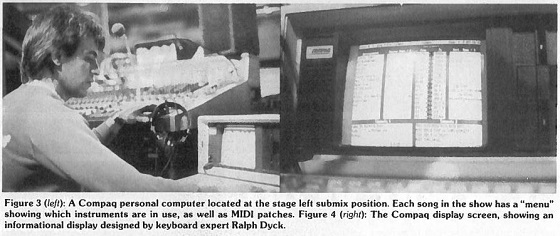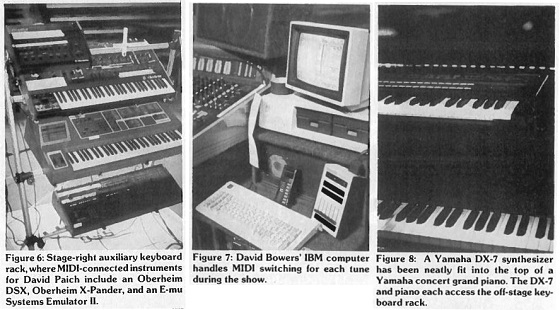
Several primary keyboards are located on stage at Steve Pocaro’s position, including a Yamaha DX-7. Interface cabling connects the stage area with Simeone’s setup, and those performance keyboards can access the additional instruments, including a pair of E-mu Systems Emulator IIS and an Oberheim X-Pander.
“Some of the latest electronic keyboard gear now available is being used with this show, and the factory support from companies such as Yamaha, Oberheim and Emulator has been tremendous,” Simeone confides.
“Things could get pretty complicated with this many keyboard units.” Having the auxiliary keyboard racks off-stage gave the stage a much cleaner appearance,” he offers.
To help the complex setup work smoothly, Simeone uses a Compaq personal computer placed next to his mixing desk (Figure 3). The screen editor displays a “menu” for each musical arrangement, showing what keyboard device is patched through which MIDI switch for each tune (Figure 4).
In addition, the computer program (arranged by keyboard expert Ralph Dyck) sends a pulse to a JL Cooper MS-II MIDI match-box device, when authorized by the engineer. Yamaha MIDI rack panel modules are hooked up to the various keyboard devices. A customized voltage-controlled attenuator module was designed by Jonathon Little of Village Recorder, Los Angeles, to provide a direct interface for level changing of the keyboard instruments.
Figure 3: A Compaq personal computer located at the stage left submix position. Each song in the show has a “menu” showing which instruments are in use, as well as MIDI patches. Figure 4: The Compaq display screen, showing an informational display designed by keyboard expert Ralph Dyck.
‘“This is a very high-quality way to control levels,” noted Simeone. “It would be counterproductive to put a very clean signal from a $50,000 console through a $1.50 volume pot! Steve Porcaro uses the VCA to control his whole rig, while David Paich uses his to fade different synthesizers in and out of the piano mix.”
Effects devices available to Simeone included a Yamaha REV-I digital reverberator, a DL-1500 digital delay unit, a Roland Super Jupiter, and a Lexicon Prime Time Il digital delay In addition, a Dynacord CLS-222 was available for an electronically-created Leslie rotor effect.
The entire keyboard mixing rig was streamlined, and seemingly well designed as a synergistic package. All inputs and outputs to and from the VCAs are patched, and a 42-pair multicable connects the synth rack and console. For fail-safe operation, a 16-channel manual switching panel can take over in case of MIDI “hangup.” Additionally, a MIDI “Panic Button” is supplied just in case a glitch in the complex control-signal path line causes the system to disregard a computer instruction to change over to the next song’s settings.
“On this side of the stage, Steve likes to wait until I do the changes, and then he kicks it over himself with an on-stage switch,” explains Simeone. “On stage right, I think they did have a hangup once or twice during the shows in Japan, but a quick tap of the panic button sent out a burst of signal pulses in about 30 milliseconds, and that cleared it up. The button interrupts the signal bus, and gives the circuits a chance to clear.”
David Bowers, who has worked with the Doobie Brothers and Kenny Loggins, among others, mixed David Paich’s stage-right keyboard rig. Bowers also commanded a Gamble SC24-24-II desk that was located offstage right (Figure 5). Here, a bank of MIDI-connected keyboards was directly controlled with an IBM personal computer. (Figures 6 and 7) An Oberheim DSX synthesizer with Digital Polyphonic Sequencer, Oberheim OB-8, Oberheim X-Pander and Emulator Il were all controlled by either a Yamaha DX-7 or Paich’s concert grand piano. A cut was made into the piano frame, and the DX-7 nested snugly on top (Figure 8).
“The computer, the keyboard audio mixer, and MIDI technology make things a lot easier on stage than they used to be,” states Bowers. “Instead of mountains of keyboard instruments and miles of spaghetti-like cables, you just see a man up there with his piano. But, you are hearing many of the exact voicings and synth parts that appeared on such classic tunes as ‘Africa’ and ‘Hold The Line’. The grand piano keyboard can trigger sounds that have been stored in the Emulator, which were taken directly from the album masters.”
Bowers used a Lexicon PCM60, Roland MKS-80 Super Jupiter, two Yamaha D1500 digital delays, two Roland SRE-555 Chorus Echos, and a Lexicon 224 digital reverb for special effects processing. In addition, an Aphex Compellor compressor-limiter and an Eventide H949 Harmonizer were available in the equipment racks.
As on stage-left, a JL Cooper MIDI Match-Box and a custom VCA panel formed part of the setup, along with a Yamaha MIDI Rack.



